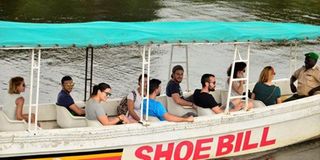Impact of infrastructural bottlenecks on tourism sector

Tourists enjoy a a boat ride. Photo by Dominic Bukenya
What you need to know:
- Some roads that connect to tourism sites are in a sorry state
- Cheap and affordable accommodation is also a challenge
Uganda is blessed with wildlife and natural scenery such as mountain ranges and water falls. The tourism sector accounts for 9 per cent of GDP and employs about 200,000 people directly and another 230,000 indirectly.
A few months ago, the government contracted Performance Horizon Group of North America, Kamageo of United Kingdom, and KPRN of Germany, to represent Uganda in the global travel markets at an annual total cost of $1.5m. The firms will market Uganda as a tourist destination in Germany, Austria, Switzerland, Ireland, UK, USA, and Canada.
In the recent past, there was a steady decline in the number of tourists visiting the country by almost 70 per cent. This was due to the Anti-Homosexuality Act, the Ebola epidemic in West Africa, and the Westgate terror attack in Nairobi.
“We believe that by 2017, we will have uplifted the industry. The Anti-Homosexuality Act created negative propaganda about us across the world and yet we rely on tourists. That Act was the worst mistake we made as a country. I hope they (MPs) do not bring that Act back to Parliament, says Mr Herbert Byaruhanga, chairman Uganda Safari Guides Association.
Poor upcountry road network
While there has been a great improvement in the roads sector in recent years, some roads that connect to tourism sites are in a sorry state. For instance, the road from Kisoro to Mgahinga Gate and to Nkuringo is not in a good shape. Also, the road from Masindi to the Murchison Falls National Park is not a comfortable one, especially since it is a long distance.
Mr Vincent Mugaba, public relations officer, Uganda Tourism Board admits that the road infrastructure is still a challenge.
“This is especially so with roads which take long to put in place. Where there is poor infrastructure it means tourists will spend more time on the road and less time enjoying the country. This increases costs for the tour operators and makes some destinations expensive.”
A poor rural road network means that some tourists will opt for the more expensive air travel to avoid the long road distances. These distances are not really long but because the road are bad, one can spend twice the time they would have spent traveling, just navigating the road.
Currently, there are few flights between Entebbe and the Albertine region, where most gorilla tracking areas are located. The distance between Kigali and the Albertine region is much shorter than the one between Entebbe and the region. The short distance attracts many tourists, thus representing lost economic opportunities for Uganda.
Accommodation infrastructure
Cheap and affordable accommodation is also a challenge. To meet with their operation costs, most accommodation in national parks is charged highly and in dollars.
There is also lack of full time electricity in the national parks such as Murchison Falls that constrains tourism development. While people would love to relax while on a tour, ICT usage should not be limited. Unfortunately, in the national parks, the electricity – mostly solar or generator – is switched off at midnight. There is also no phone network in some of these national parks. This could be construed to mean that there is little value for the tourist dollar.




